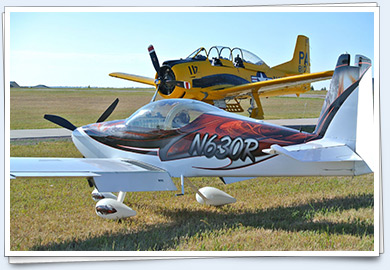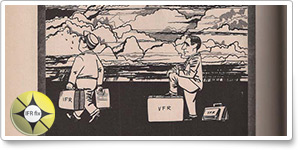| ||||||
| The second try |
| |||||
Training TipsThe second try
Too often that’s where the discussion ends. What’s the next step?
The answer isn’t always a second attempt to land on the same runway. But if that is the call, the pilot should use the extra time to regain any lost composure, and then focus on clearly understanding why things didn’t go as planned.
Second attempts also demand caution, as a recent overrun accident on a private runway may illustrate.
Faced with landing on a moderately short, narrow, grass runway, a Navion pilot did the prudent thing by flying over to survey the situation before an aborted attempt to land, according to a preliminary report.
But the second landing attempt also failed. After touchdown around the runway's mid-point, braking did not slow the aircraft sufficiently to stop on the landing surface. Now out of position for a go-around, the pilot's remaining option was to use an overrun area.
But, “the long grass concealed a 20- to 30-foot steep slope. The airplane exited the end of the runway, went down the slope, crossed a gravel road and impacted small trees,” the report states.
There was one important piece of data about the private airstrip unavailable to the pilot, who later realized that “the runway had a significant down slope which he could not identify during his flyover prior to landing.”
How much of a factor is that?
“Here is a rule of thumb: For every 1 degree of upslope, add 10 percent to your takeoff roll. Or add 10 percent to your landing roll when touching down on a 1-degree down-sloping runway,” said the Sept. 24, 2004, “Training Tip: Runway Gradient.” It also reminded pilots that performance charts provided in their pilot's operating handbooks are based on level, dry runways, both for paved and unpaved surfaces.
A second try to land is one of the scenarios that can make a pilot feel pressured to get down now, regardless of the consequences. But just as there is no law that says that a controlled flight must be completed on the first landing attempt, the same is true for the second—especially if the problem that caused the original go-around (for example, touching down too far down a short runway) has not been remedied.
Want some additional insights into landings? View the recorded Air Safety Institute Webinar, “Takeoffs and Landings: The Expert Approach.” Flight Training NewsNew chance to comment on medical petitionMore than 14,000 pilots made their voices heard under a tight deadline to comment on a joint petition by AOPA and EAA to allow pilots to fly under certain circumstances without being required to hold a third-class medical certificate. The FAA has now granted more time for pilots to speak up, and explain to regulators how medical self-certification informed by knowledge gained from an online course will enhance operational safety while eliminating a significant burden for many pilots. Read more >> Cessna launches Skycatcher promotional tourWhat if you had just graduated from college and someone hired you to fly a small trainer around the country? Nine flight instructors, most graduates of university aviation programs, got the call from Cessna Aircraft Co. to serve their industry, and all willingly complied. Read more >> Hypo-what? Learn about aeromedical mattersHas it been a while since you studied flight physiology? See if you can answer these questions confidently: Do you need a current medical certificate to act as safety pilot? What's the difference between hypoxia, hypoglycemia, hypochondria, and hyperventilation? What are the symptoms of carbon monoxide poisoning? Take the Air Safety Institute’s Aeromedical Matters safety quiz, sponsored by the AOPA Insurance Agency. Take the quiz >> International student pilots grounded in contract disputeMore than 180 international students in Melbourne, Fla., are grounded while their flight training provider disputes a contract. Florida Institute of Technology reportedly terminated an agreement with Ireland-based Pilot Training College, saying it is owed about $1.2 million for flight training, room, and board. PTC asserted that Florida Tech did not provide training in a timely and professional manner, according to FloridaToday.com. Resuming the journey: Wrapping up the flight reviewIn her quest to become current so that she can fly in Alaska, AOPA staff member Kathy Dondzila deals with a family issue that affects her schedule. When she returns to the airport, she also has to become familiar with a new control tower. Read more >> Training ResourcesWouldn’t it be great if someone took much of the important information you need to know about an aircraft and compiled it into one place? And wouldn’t it be great if that information were available in an easy-to-find format? Look no further than the Air Safety Institute’s Aircraft Flash Cards. Download the customizable cards for each aircraft you fly and never again find yourself searching the checklist for V-speeds or fuel capacity. They work great when you’re studying for that oral exam, too.
Did you know that student pilots who join AOPA are three times more likely to complete their flight training? Membership includes unlimited access to aviation information by phone (800/USA-AOPA, weekdays from 8:30 a.m. to 6 p.m. Eastern time) or from Flight Training Online or AOPA Online. If you’re not already a member, join today and get the pilot’s edge. Login information is available online. Stunt pilot Corkey FornofJ.W. “Corkey” Fornof has been flying airshows since 1967, completed more than 3,000 aerial demonstrations, and flown in 46 feature films. Perhaps his best-known sequence is when he flew a BD-5J microjet sideways through hangar doors in the James Bond film Octopussy. How did he prepare for such an incredible stunt? How many times did he fly through the hangar to get that exact shot? As Fornof explains in this interview during AOPA Aviation Summit 2011, “You don’t get paid to take risks, you get paid to eliminate risks.” Career PilotJetBlue flies RNP AR approachesIn a blog post published June 20, JetBlue announced that it has become the first FAA-certified carrier in the United States to utilize the new satellite-based special (nonpublic) required navigation performance authorization required (RNP AR) approaches to Runways 13L and 13R at its home base, New York City’s John F. Kennedy International Airport, using Airbus A320 aircraft. According to the post, the approaches utilize performance-based navigation to provide a constant vertical descent, in conjunction with a precise curved flight path to the runways that results in a stabilized approach path, shorter flight times, reduced noise levels, and fuel savings. JetBlue began designing and testing the JFK special instrument procedures in 2004, and said its more than 2,300 pilots have been trained and certified to fly RNP AR procedures across the National Airspace System. Southwest, AirTran mechanics agree on seniority integrationAircraft maintenance technicians from Southwest Airlines, represented by the Aircraft Mechanics Fraternal Association, and AirTran Airways, represented by the International Brotherhood of Teamsters Local 528, voted to ratify a seniority integration agreement June 21. The agreement integrates the two groups’ seniority lists. Southwest Airlines closed on its acquisition of AirTran Holdings Inc. on May 2, 2011. The combined carriers’ pilots, flight attendants, flight instructors, dispatchers, and ramp and operations agents already have completed the seniority integration negotiation process. Plane SpotterR22: Readily recognizable rotorcraft Training ProductsHeadset/flight bag bundle from PilotMall.comPilotMall.com is offering an AvShop Design bundle that includes an A250 headset and a Halifax flight bag. The headset weighs 11 ounces and provides stereo sound, a cell-phone interface, and 24 decibels of noise reduction. The bag includes twin headset compartments and is padded throughout. It measures 21 by 12 by 13 inches and weighs 68 ounces. The bundle sells for $149.99. Order online or call 800/249-5730.
Note: Products listed have not been evaluated by ePilot editors unless otherwise noted. AOPA assumes no responsibility for products or services listed or for claims or actions by manufacturers or vendors. Member BenefitsAOPA Term Life: Build financial security for your familyIf something happened to you, would your family have enough assets to make sure they maintain their current lifestyle? Would they have enough to pay everyday living expenses and children’s college education, and to help them meet all the other financial obligations that you and your income provided for? According to the LIMRA 2010 Life Insurance Ownership Study, 35 million Americans have no life insurance protection at all. And of those who do have coverage, most don’t have enough to ensure a secure financial future for their families. Read more >> | ||||||||||||||||||||||||||||||||||||
| |||
AVIATION EVENTS & WEATHER
| To include an event or to search all events in the calendar, visit AOPA Online. For airport details, including FBO fuel prices, see AOPA Airports. | ||||||||||||||
Final ExamQuestion: Do the federal aviation regulations or Aeronautical Information Manual state the proper altitude to begin your turn from the departure leg to the crosswind leg when remaining in the pattern? My instructor told me it is the traffic pattern altitude for the particular airport, minus 300 feet. Is that just good advice or does it come from a regulation?
Answer: This has long been a topic of hangar conversations. According to the Aeronautical Information Manual Chapter 4 Section 3, “Airport Operations,” the departure leg is defined as “the flight path which continues straight ahead along the extended runway centerline and continues until reaching a point at least one-half mile beyond the departure end of the runway and within 300 feet of the traffic pattern altitude.” The crosswind leg is “a flight path at right angles to the landing runway off its takeoff end.” So the AIM recommendation agrees with your flight instructor’s good advice to turn onto the crosswind leg once the departure leg is completed, which is 300 feet below pattern altitude.
Got a question for our technical services staff? Email [email protected] or call the Pilot Information Center, 800/872-2672. Don’t forget the online archive of “Final Exam” questions and answers, searchable by keyword or topic. Instrument Tip | ||||||||||||||
Flight Instructor Refresher Clinics | Air Safety Institute Safety Seminars | |||||||||
For a complete schedule, see AOPA Online. Can’t make it in person? Sign up for the CFI Refresher Online. |
Topics vary—for details and a complete schedule, see AOPA Online. | |||||||||
| | ||||
| ePilot Flight Training Editor: ePilot Editor: | Contributors: | | Production Team: | Advertise in ePilot: |
| Member Tools: Send feedback | ePilot Archive Got news or questions? Contact ePilot. Having difficulty using this service? Visit the ePilot Frequently Asked Questions online at AOPA.org or email us. | ||||




 Conventional wisdom pounded home to generations of pilots states that if a landing doesn’t look or feel right,
Conventional wisdom pounded home to generations of pilots states that if a landing doesn’t look or feel right, 




